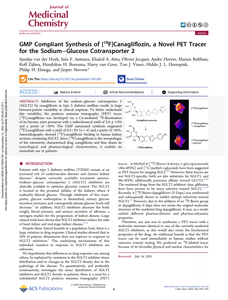Inhibition of the sodium−glucose cotransporter 2 (SGLT2) by canagliflozin in type 2 diabetes mellitus results in large between-patient variability in clinical response. To better understand this variability, the positron emission tomography (PET) tracer [18F]canagliflozin was developed via a Cu-mediated 18F-fluorination of its boronic ester precursor with a radiochemical yield of 2.0 ± 1.9% and a purity of >95%. The GMP automated synthesis originated [18F]canagliflozin with a yield of 0.5−3% (n = 4) and a purity of >95%. Autoradiography showed [18F]canagliflozin binding in human kidney sections containing SGLT2. Since [18F]canagliflozin is the isotopologue of the extensively characterized drug canagliflozin and thus shares its toxicological and pharmacological characteristics, it enables its immediate use in patients.

The studies in this thesis aim to increase understanding of the effects of various characteristics of scientific news about a common chronic disease, i.e., diabetes, on the cognitive responses (e.g., emotions, attitudes, intentions) of diabetes patients. The research questions presented in this thesis are guided by the Health Belief Model, a theoretical framework developed to explain and predict healthrelated behaviours based on an individual’s beliefs and attitudes. The model asserts that perceived barriers to a recommended health behavior, advantages of the behavior, self-efficacy in executing the behavior, and disease severity and personal susceptibility to the disease are important predictors of a health behavior. Communication is one of the cues to action (i.e., stimuli) that may trigger the decision-making process relating to accepting a medical or lifestyle recommendation.

A substantial proportion of chronic disease patients do not respond to self-management interventions, which suggests that one size interventions do not fit all, demanding more tailored interventions. To compose more individualized strategies, we aim to increase our understanding of characteristics associated with patient activation for self-management and to evaluate whether these are disease-transcending. A cross-sectional survey study was conducted in primary and secondary care in patients with type-2 Diabetes Mellitus (DM-II), Chronic Obstructive Pulmonary Disease (COPD), Chronic Heart Failure (CHF) and Chronic Renal Disease (CRD). Using multiple linear regression analysis, we analyzed associations between self-management activation (13-item Patient Activation Measure; PAM-13) and a wide range of socio-demographic, clinical, and psychosocial determinants. Furthermore, we assessed whether the associations between the determinants and the PAM were disease-transcending by testing whether disease was an effect modifier. In addition, we identified determinants associated with low activation for self-management using logistic regression analysis. We included 1154 patients (53% response rate); 422 DM-II patients, 290 COPD patients, 223 HF patients and 219 CRD patients. Mean age was 69.6±10.9. Multiple linear regression analysis revealed 9 explanatory determinants of activation for selfmanagement: age, BMI, educational level, financial distress, physical health status, depression, illness perception, social support and underlying disease, explaining a variance of 16.3%. All associations, except for social support, were disease transcending. This study explored factors associated with varying levels of activation for self-management. These results are a first step in supporting clinicians and researchers to identify subpopulations of chronic disease patients less likely to be engaged in self-management. Increased scientific efforts are needed to explain the greater part of the factors that contribute to the complex nature of patient activation for self-management.
